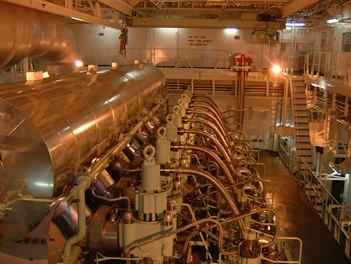
Steamship Mutual
Published: November 01, 2014

Owners and charterers of time chartered vessels where the vessel's consumption is described to be "about" need to be aware of the recent High Court decision in The Gaz Energy No.2 (Hyundai Merchant Marine Co. Ltd. v Trafigura Beheer BV [2012] EWHC 1686 (Comm)). The High Court has now re-affirmed that when calculating the consumption to determine over-consumption the upper limit of the "about" range is to be used. However, it clarified that for the purposes of set-off and under-consumption the vessel's consumption should be calculated by reference to the lower limit of that range. The case establishes a legal precedent on a practical time charter issue that has been missing from the relevant case law and displaces the decision of London Arbitration 20/07 (where the mean figure was used).
Speed and performance issues can still cause problems but in fact the law on how to calculate under- and over-performance was quite settled apart from how to apply a set-off for any bunker under-consumption. With hire rates low and bunker prices high, this issue can often be crucial in determining the extent to which hire can be deducted. The courts have now ruled on the issue thereby explaining the method of calculation. (Hyundai Merchant Marine Co Ltd v Trafigura Beheer BV (The Gaz Energy No 2) [2012] EWHC1686 (Comm)).
The starting point is that an issue arising out of a performance warranty clause in a charterparty is one of construction. That means that the Court’s inquiry is to ascertain the meaning which the clause (within the context of the whole charterparty) would convey to a reasonable person having all the background knowledge which would reasonably have been available to the parties in the situation in which they were at the time of the contract. The test is an objective one and what the subjective intentions of the parties were is irrelevant.
In legal parlance, the word “about” imports a range of “allowable contractual performance”. The general legal principle in the law of damages is that when a party is sought to be held liable in damages for breach, that party is entitled to have its liability measured by reference to the minimum obligation within the allowed range of performance. Any performance above that range will be over-performance and any performance below that range will under-performance.
When a consumption warranty includes the phrase “about” it is generally accepted by the courts and arbitrators that an allowance of 5% should be applied. Thus where consumption is defined at say “about 40 metric tons per day”, the allowable range is between 38 metric tons and 42 metric tons. In terms of bunker consumption, there will be an “under-performance” when the vessel “over-consumed” bunkers. This is the case when the shipowner is to be held liable for over-consumption. As regards over-consumption the judicial position is clear – the calculation will be made by reference to the minimum obligation within the “allowable contractual performance”, that is the upper limit; in our example 42 metric tons (“The Al Bida” [1986] 1 Lloyds Rep 142).
As regards “over-performance” which in terms of bunker consumption is “under-consumption” arbitral tribunals have varied, with some going for the average figure i.e. the stated daily consumption. For instance, in accordance with an earlier LMAA Tribunal (London Arbitration 20/07) the figure to be applied in our example should be 40 metric tons.
Consider, for instance, the case where the vessel has under-performed in terms of speed which would give rise to a longer sea passage and thus loss of time to charterers but has also only consumed 36 metric tons per day. Owners had promised and thus charterers could expect a consumption of “about 40 metric tons” which by reference to the minimum obligation within the allowable range of performance can be up to 42 metric tons per day. Thus have owners saved charterers 6 metric tons per day; 2 metric tons per day (based on 38 metric tons consumption); or should we look at applying 40 metrics tons without any allowance? In other words, the issue is: when does under-consumption start? At less than 42 metric tons; at less than 38 metric tons; (or at less than 40 metric tons in accordance with the above LMAA decision?
Having considered the arguments in the Gaz Energy No 2, the Court has found that one needs to calculate under-consumption by reference to the lower end of the scale. In the example this would be 38 metric tons thus a saving of just 2 metric tons per day. In arriving at its decision, the Court clarified the meaning of the word “overperformance”. The Court held that “overperformance” meant a performance better than that warranted. In the example, “about 40 metric tons” meant a consumption between 38 and 42 metric tons per day. If the daily consumption was less than 38 metric tons the vessel clearly performed better than warranted, i.e. she overperformed. With any consumption between 38 and 42 metric tons per day the vessel was not performing better than the warranted performance as it was performing in accordance with the warranty; therefore she did not overperform (nor did she underperform for this to happen she should have consumed more than 42 metric tons per day). In accordance with the general principle of construction set out above, that was how the reasonable man would have understood the clause.
Paragraph 18 of the Judgment appears to be of particular importance and contains the relevant maxim. The Judge said that:
"[w]here the guaranteed maximum consumption is expressed by reference to a range (“about 40 mt” per day) it seems to me to be right in principle to assess underperformance by reference to the upper limit of that range, 42 mt per day, and to assess overperformance by reference to the lower limit of that range, 38 mt per day".
This dictum is of a general application, not restricted to the factual context of the particular case, and establishes a legal precedent on a practical time charter issue that was previously missing from the relevant case law.
Overall, the above decision is a pro-charterer decision. Looking ahead, caution should be given when vessels are chartered on a back-to-back basis. However, from a charterer’s perspective, where the "about [X]" consumption is quoted by owners for chartered in tonnage but this is changed to "maximum [X+5%]" consumption for the same tonnage when chartered out, the charterer may claim as owner down the charter line a credit from bunkers saved on the basis of the "maximum" provision but will not be obliged to pass such benefit to the head owner up the line of the charters, if this was still within the "about" range.
This decision displaces the decision of London Arbitration 20/07.
With thanks to Richard Gunn and Kostas Bachxevanis of Reed Smith for preparing this article.


